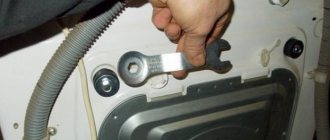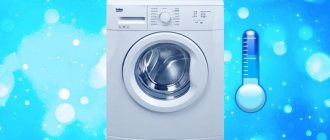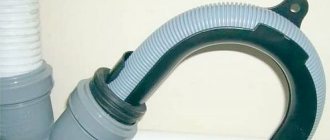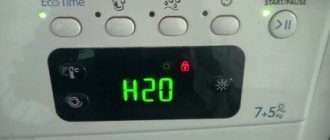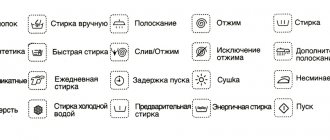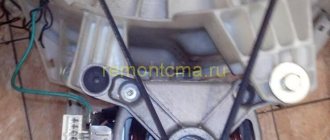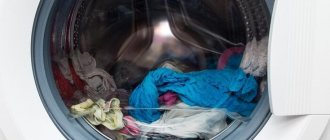Acceptable noise limits
Each washing machine comes with an instruction manual that contains information about the noise level.
The rate may vary and depends on the technology and drive option:
- belt varies from 60 to 72 dB;
- direct from 52 to 70 dB.
The level of these decibels is not silent, but also does not cause discomfort to users. How can you tell if the machine is making such a loud noise?
Accurate measurement is possible using a sound level meter . There are Chinese models that are quite inexpensive. But it is not always possible to purchase this equipment. What should I do?
There are many associations with strength in DB. For example, a sound of 50 dB is typical of a typewriter, and at 95 dB a train in the subway is heard. The jackhammer operates with a noise level of 120 dB. You can focus on these indicators. If you feel that the washing machine is humming a lot and making some strange noise, then you should find the reasons and fix the problem.
It is important to understand at what point unpleasant sounds occur - during washing, spinning, rinsing or draining.
Reasons for the hum of a washing machine
The washing machine can make an unnatural sound in different operating modes: when washing or draining water, while spinning or rinsing clothes. You need to listen to this sound and try to determine its characteristics as accurately as possible. This will help determine the cause of the problem with the washer.
There are 6 reasons why a washing machine hums when washing:
- incorrect installation of the washing machine;
- foreign objects;
- wear of parts;
- weakening of the pulley;
- malfunction of counterweights;
- drain pump malfunction.
Let's take a closer look at the characteristics and causes of noise in a washing machine.
Incorrect installation of the washing machine
If the washing machine vibrates and rattles too much, wobbles, bounces and moves out of place at the end of the wash, it is most likely not installed level.
- Adjust the legs of the machine so that it is level and horizontal. Use a level to ensure accurate measurements.
- To minimize the noise level, place a soft cloth or special anti-vibration stands under the machine’s feet.
A common mistake of incorrect installation is also unscrewed transport bolts. They are needed to secure the washing machine drum during transportation. During installation, they had to be removed and replaced with plastic plugs included in the kit.
- Look at the back of the car. If you find shipping bolts, unscrew them and replace them with plugs.
Foreign objects
If a working washing machine begins to knock, crackle and squeak, the reason may be simple: the sound of foreign objects.
The unit can hum from parts of clothing with buttons and hooks that knock on the glass of the washing machine and the walls of the drum. In this case, it will be easy to solve the problem. Remove the item of clothing making the sound from the drum, place it in a special perforated washing container and return it back. The knocking will stop.
Sometimes the contents of clothing pockets get into the machine: lighters, keys, wire, coins and other foreign objects. They can get stuck in a variety of places. To remove rattling items caught in the sealing collar or inside the drum, simply stop the wash and open the lid to eliminate the source of the problem.
When washing, the machine hums if a foreign object is stuck at the bottom of the tank or gets under the heating element. You need to pull out the heating element, remove the interference and install the part back.
ATTENTION! FOR SAFETY PURPOSES, DISCONNECT THE WASHING MACHINE FROM THE POWER BEFORE DISASSEMBLYING AND DRAIN THE WATER!
Carefully inspect the back cover of the washing machine. If it is large, the heating element is located behind the lid at the bottom. Unscrew the cover, remove the terminals to turn off the power to the heating element, loosen the fastening nut on the hairpin, press on the hairpin, carefully remove the heating element and fix the problem: remove the stuck object with tweezers. To restore the washing machine, do the same steps in reverse order.
Wear of parts
The reason why the machine makes a whistling, grinding or rustling sound when washing may be the end of the service life of its individual elements, for example, metal bearings. These parts perform a very important function in the operation of the machine: they support the drum during rotation and swing and evenly distribute the load.
The warranty that the manufacturer gives for the washing machine applies mainly to the engine. Parts such as bearings and shock absorbers tend to fail faster. The service life of parts depends on the quality of the components and operating conditions of the washing machine.
To protect the bearings in the machine, there is a rubber seal, which over time becomes hard and begins to crumble. A damaged oil seal does not provide proper sealing; it allows water to enter the bearings, and they rust.
Thus, if the washer whistles during washing, the problem is wear of the bearings. There is a way to check this even when the machine is turned off.
- Try pushing the drum and spinning it. If the movement is uneven, the root of the problem has been found correctly. If there is no opportunity or desire to use the services of a specialist, you can replace the bearings yourself. The whistling sound during washing will disappear.
- Remove the front panel, unfasten the control panel and the bottom panel. Then remove the back panel and remove the heating element (using the method described in the section on removing foreign objects). The engine is located behind the heating element; it also needs to be removed from the machine body. Afterwards, disassemble the tank, which consists of two parts connected by bolts. Finally, knock out the old bearings and install new ones. Then reassemble the washing machine by performing the steps in reverse order.
Pulley loosening
If the machine makes abrupt clicks during operation, the pulley may have become loose. This is a round part, similar to a bicycle wheel. It is attached to the washing machine drum with a large bolt at the back and ensures smooth and uniform movement of the drum in a circle. Over time, the fastening weakens, and the drum becomes loose and its rotation becomes uneven. The solution is simple:
- Unscrew the bolt located in the center of the pulley, lubricate it with sealant and firmly screw it back to the base.
Counterweight malfunction
The machine may hum loudly when washing, and when spinning, jump to the sides due to strong vibration if the counterweights are broken.
These parts provide balance and stability to the tank. Without this condition, the spin function cannot be performed correctly. Counterweights are weights that balance the position of the washing machine tank and soften the force of its vibrations.
During operation, the mounting points of the counterweight bolts may become loose.
- To strengthen them, feel for the bolts on the outside of the washer tank with your hand, take a flashlight and tighten the bolts more tightly.
Drain pump malfunction
If you hear a hum in the washing machine when the water drains, but the water does not drain, the problem is most likely in the drain pump. Small items forgotten in clothing pockets can damage the part.
Experts consider this part a consumable item and recommend replacing it every five years, subject to careful use. In some cases, the pump does not require replacement. You just need to clean the filter, which is located behind the door on the front wall of the washing machine. Then check the hose to the pump and the pump itself.
- Open the door with a screwdriver, place the bowl under the flowing water, unscrew the filter to clean it and remove all excess from there.
- Check the pipe for blockages inside.
- Remove the tube from the pump, unscrew the fasteners and pull out the pump.
Noise Prevention
Following and observing small rules will allow you to avoid noise malfunctions of the machine. All you need is:
- do not shove too much laundry;
- do not run the wash several times in a row;
- do not frequently use the washing cycle at very high temperatures;
- do not forget to clean the filter;
- do not allow laundry to be washed with foreign objects in the pockets;
- Do not use very hard water; if this is not possible, then be sure to soften it.
Owning a washing machine means caring for it and being attentive to it. Timely diagnostics and troubleshooting mean many years of equipment operation.
Identifying a problem by sound
The greatest noise from the SMA comes from spinning, which is explained by the high speed of rotation of the drum. If the noise level is 75 dB, then there is nothing strange about excessive volume. To determine the cause of the malfunction, you need to listen to the sound, which can be:
- increasing, uncharacteristic of the washing process;
- vibrating strongly during spinning;
- resembling blows or grinding sounds.
Such sounds can occur when washing items with metal elements. If such violations are constant, then this is the main sign of minor or serious damage.
If the color of the water changes when draining, rusty spots begin to appear on clothes after washing, the drum begins to jam or there are leaks, and all this is accompanied by a roar, then this indicates wear on the shaft, oil seal and bearing. To repair the part, the intervention of a specialist is necessary. You can independently determine the common causes of the malfunction.
The drain filter is broken
Owners often encounter unpleasant noise and crackling noises when draining water during and after washing. In order to identify the causes of unpleasant sounds, you should examine the drain system for breakdowns. The most common cause is a malfunction of the drain filter, and this is where the inspection should begin. It is located in the lower right corner of the washing machine and can be reached by opening the door. The filter often becomes clogged with foreign objects, so it should be removed and washed thoroughly. It is necessary to examine the space behind the drain filter and, if contamination is observed, clean it too. If a part is deformed or faulty, it must be replaced.
Tips for avoiding malfunctions
In order for the “helper” to last longer, you must strictly adhere to the operating rules. Among the most important rules are:
- do not wash more clothes than is provided for in the machine’s passport;
- clean the drum for preventive purposes;
- programs that provide high water heating should be used to a minimum;
- after each wash, the hatch must be open;
- if necessary, wash several times a day, take a break between cycles;
- use of water softeners.
It is also important to turn items inside out before washing. These precautions will help your washing machine last longer.
The drum rubs against the rubber cuff
If all parts of the washing machine are in working order, but noise is still heard during washing, you should check the condition of the sealing collar. It often does not fit in size, so when washing it rubs against the lid and creates an unpleasant noise. The fact that the noise is caused by cuff friction is the presence of pieces of rubber on the surface of the cover. In this case, it is necessary to replace the cuff with a suitable one. You can also attach a piece of sandpaper to the side of the drum and turn on the spin mode. The sandpaper will erase the excess rubber, which will allow you to achieve the required cuff size. Don’t forget about cleaning the machine from rubber residues, so after spinning it’s worth turning on the rinse mode and then cleaning the filter.
Spring breakage
If the spring breaks, the drum may tilt to one side. However, it can look exactly the same if the shock absorber breaks down. To accurately identify the cause, it is necessary to disassemble the machine. This is done at the service center, and if there is a faulty spring, it is replaced. If you ignore the problem, then when washing the drum will poorly center the laundry and constantly sway.
A broken shock absorber has very similar symptoms to a broken spring:
- the drum “sags” to one side;
- The washing machine cannot center the laundry correctly;
- there is a permanent imbalance.
In addition to the shock absorber, the mount may break, or the mounting bolt may simply become loose. It is possible to determine why the extraneous sound occurs only after disassembly. It is recommended to first carry out diagnostics by calling a specialist. After identifying a malfunction, the shock absorbers are replaced with new ones.
Reviews
Alexey, Belgorod
The wife said that the washing machine began to make noise when filling in water and when draining, but the operating process itself proceeded as usual. I checked the operation of the SMA myself and decided to look for a possible cause on the Internet. Judging by the signs of malfunction, the drain pump has failed. I opened the back wall of the machine, as indicated in the description, took out the pump and replaced it with a new one. The noise stopped. Thank you for the useful article.
Ilona, Rostov-on-Don
I noticed that my beloved SMA began to work with excessive noise. I was scared because I thought I would have to buy a new device. But after turning to the Internet for help, I realized that the reason could be foreign objects. After finishing the wash, I took out the change that had fallen out of my pockets. And when my husband came home from work, he looked at the channels and took out the debris that was between the heating element and the drum. Thanks for the advice.
What can you do
We have looked at the reasons for the knocking noise, and in terms of repairs, you can try the following. First of all, check how level the machine is; if necessary, align the legs. If the washer is new, be sure to check if the shipping bolts have been removed. Check whether the tank is overloaded with laundry and how evenly it is distributed.
Check the suitability of the bearings. To do this, rotate the drum from side to side, as well as up and down. If a knock is heard and play is noticeable, then it’s time to change the bearings.
One of the common causes of knocking is failure of shock absorbers. To fix the problem, you will have to change both, even if only one is worn out, since it is impossible to choose a pair that matches the hardness.
If you still want to continue to look for the fault yourself, first disconnect the machine from the power supply and provide access to the rear wall.
- If necessary, turn off the water supply.
- Remove the top cover, then the back wall.
- Inspect the condition of the internal parts.
You may notice a broken spring mount, a cracked weight block, or a broken shock leg. Then these units must be replaced. If the reason is a torn-off surge protector, it must be securely attached in place to the machine body using self-tapping screws.
Important: if you are not confident in your abilities, do not carry out any work. Remember that the average weight of this equipment ranges from 45 to 65 kilograms. It is installed and leveled, be prepared to install it after disassembly. Be sure to turn off the power to the product to avoid electrical shock during the repair process.
When the knocking is accompanied by grinding, creaking and other prolonged noises, this may indicate a failure of the drum bearing. This doesn't happen often, but it does happen. This kind of breakdown is the most expensive to repair.
